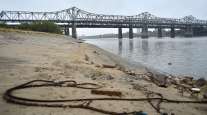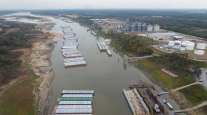Ag Haulers Prepare for Pain as Drought Plagues Nation
This story appears in the July 30 print edition of Transport Topics.
The severe drought that has devastated farmers and cattlemen from Montana to Texas and from Kentucky to Colorado is now set to hit trucking companies that haul grain and soybeans, industry officials said.
“This is a terrible drought and it is significantly affecting crops coming off the field. It will impact loads coming out of the Midwest and the impact won’t stop there,” said Jon Samson, executive director of the Agricultural and Food Transporters Conference of Ameri-can Trucking Associations.
If crop yields are poor, “that damn near eliminates the work for the most part,” said Kevin Brotherton, owner of Brotherton Farms Trucking LLC, a 30-tractor grain hauler out of Chillicothe, Mo. “When you have a good yield, then everyone has freight. When you have medium yield, everyone fights over it. If you have a bad yield, then there’s nothing,” Brotherton said.
The drought has slammed Missouri, Iowa, Kansas, Nebraska and southern Illinois and Indiana.
The big worry in Missouri is that grain yields could drop to 50% of normal, said Ray Massey, an economics professor at the University of Missouri. “We’ve been hit by the brunt of the drought here.” Massey said most farms have hopper-bottom trucks to haul grain to country elevators. From there, it’s carried by rail or barge, he said.
But the full effect on commercial trucking companies that haul grain from country elevators to terminals won’t be known until fall harvest time, said Tom Tunnell, spokesman for the Kansas Grain and Feed Association.
Jeremy Girard, grain merchandiser at Hannebaum Grain Co. in Salina, Kan., said low yields create difficulty for grain haulers as well as producers. He said low yields put grain shippers in a bind when it comes to choosing which motor carriers to use.
“You could end up with a surplus of trucks, and then you must be more creative in creating loads for the guys who do regular runs for you. We want to keep them hauling for us,” Girard said. “It’s a bad feeling when you have to tell someone you have no work for them.”
In South Dakota and North Dakota, low yields are the big fear. “I guess at this point, we’re looking at a 30% reduction unless we can get some decent rain,” said Bill Pool, director of marketing and communications at the South Dakota Wheat Growers Association.
The U.S. Department of Agriculture has reduced its estimate of corn yields by 20 bushels per acre and said 38% of the crop is doing poorly. Pat Walsh, who grows corn with husband Albert on 2,000 acres in Carmi, Ill., said their fields have produced little but miniature cobs. “The corn is past [pollination], so rain won’t help,” said Albert Walsh. “It’s done for.”
This is troubling for Grammer Industries Inc., a Grammer, Ind., hauler of fertilizers and other chemicals that counts farmers as its customers. “A lot of these guys can’t pay their feed bills now,” said Grammer president Charles “Shorty” Whittington. If farmers lose money and don’t have crop insurance, it could affect their ability to buy fertilizer next planting season, he said.
On July 11, the Agriculture Department changed rules allowing counties to be declared disaster areas if the U.S. Drought Monitor reports them suffering drought for eight straight weeks during a growing season. The move also allows farmers to get emergency loans priced at 2.25% instead of 3.75% for drought recovery.
Ironically, the drought is giving a short-term boost to livestock haulers, as Midwest cattlemen, desperate to save their herds without selling out, are shipping livestock hundreds of miles to get them out of the drought zone.
Allen Anderson, owner of Har Livestock Dispatch Inc., Holdrege, Neb., said he’s been dispatching about six trucks a day loaded with cattle bound for feedlots in Oklahoma and Texas, but also as far away as Minnesota, Wisconsin and California.
While many cattlemen ship, others hope for rain. But the drought will force them to either sell or ship, Anderson said. “We’re getting into a situation where people are going to have to make a major decision.”
Larry Johnson, president of the Nebraska Trucking Association, said his state’s farmers and cattlemen face a dilemma. “They have decide: ‘Do we water the corn or water the cattle?’” he said.
Johnson said it’s too early to tell exactly how the drought will affect his member companies.
The drought has prompted Missouri to issue special overweight hauling permits to help farmers move hay for livestock. The fee-free permit is good through Dec. 31.
Samson said he believes that when harvest season begins in the fall, the true extent of the drought’s devastation will become evident.
“A month ago, this wasn’t much of an issue,” he said. “But this month, we’ve been hearing from governors declaring some counties disaster areas. You usually see these declarations in the fall. When you hear of them in July and August, it’s not a good thing.”
Water levels on the Mississippi River are 15 feet below its level at this time last year because of the drought, said Dave Berretta, chief of the hydrology branch of the U.S. Army Corps of Engineers in Memphis, Tenn. “But there’s little navigation issues. The towing industry is simply light-loading barges and restricting tow sizes,” he said.
Many loads at Oakley Barge Line Inc., North Little Rock, Ark., are down about a quarter, said dispatcher Josh Childress.
“Each barge is carrying less cargo, so there may be a need for more trips,” he said. But as long as the river stays open, little freight will be shifted to rail or truck, Childress predicted.




